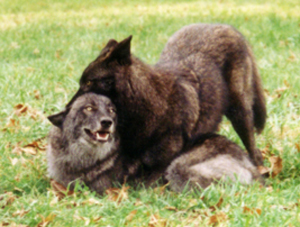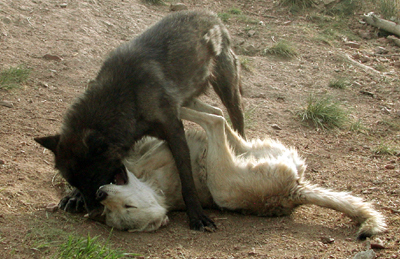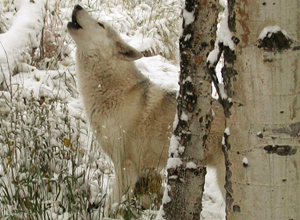Wolf Behavior
In order to care for wolves in captivity, and co-exist with them in the wild, we must first understand their behavior. Scientists have been studying wolf behavior for over 60 years. Only recently have we begun to understand the complexity of their lives. Through watching our own domestic dogs and observing wolves in the wild light is being shed on the mysteries of the wolf world.

Social Pack Structure
The wolf is a social animal. Wild wolves usually live in packs of 2-15. A pack is typically composed of a breeding pair of wolves known as the alphas, their young pups, and their offspring from earlier years. There are four categories of wolves in a well-established pack. The alpha pair are responsible for the leadership of the family. They initiate hunting trips, maintain order and harmony, and are the primary caregivers for the pups. Mature subordinate adults help with the hunting but rarely challenge the dominant alphas. Omega or outcast wolves live on the periphery of the pack's social core. Juveniles and pups have not yet entered the social hierarchy of the pack and look to adults and older siblings for guidance.
Wolves are very social animals that form strong bonds with their pack-mates, much as we bond with our families. Many people have observed that the wolf is a near mirror of our own society, with only the absence of our excessive violence toward each other. The alpha male and female of a wolf pack act as the mother and father of the family. They lead the pack as equals and make many of the daily decisions. Usually each year, it is only the alpha pair that breed and have pups. All members of the pack work together to care for and raise the little pups, regardless of their genetic relationship with them. There is a Native American saying: there’s no such thing as an orphan in the wolf world. Wolf puppies are almost universally loved and accepted, even adopted by another female or pack if need be. Cooperation is the name of the game in a wolf pack with all members working together during the hunt and in raising the next generation.
The bonds that wolves form with each other are extremely strong. Most bonds are formed when a puppy is very small, usually when it is less than six months old. This makes sense in the wild because young pups are only surrounded by their pack mates and must learn early on who they can trust. However, as a pup grows and starts to explore its environment, it is liable to run into an outside wolf or other animal that may pose a threat and should not be bonded with.

Play Time
Wolves have thick fur and tough skin and are built to deal with wolf-y play. To show affection and have a little fun, wolves chew on each other’s faces, growl and snap and drag each other across the ground. This is their idea of a great time... unfortunately most humans see this as aggression. Now imagine that you had raised a wolf pup to be your pet and friend. As it grows to be larger than a German Shepherd, it will continue to want to play with you. Your beloved pet will hit you at 20mph and sink its teeth into your hip. You’re supposed to do two summersaults, jump up and say, “Wow, that's fun!” In other words, wolves are wild animals, not to be played with.

Howling
Wolves communicate by howling. All wolves howl in the key of E, the same key as whales and dolphins, but each wolf has its own distinctive voice. There is no predicting when a pack of wolves will howl, and no, they do not howl at the full moon. Usually, a howl by one wolf is quickly followed the rest of the pack. If you listen to a pack long enough, you can learn to identify individuals by their howls.
There are many theories about why wolves howl. To increase family bonding. To find a lost pack member. To tell the world a large wolf pack lives here. To gossip with each other. No one knows for sure, but we do know that wolves have a distinctive (although unintelligible to humans) and complicated vocal language.
